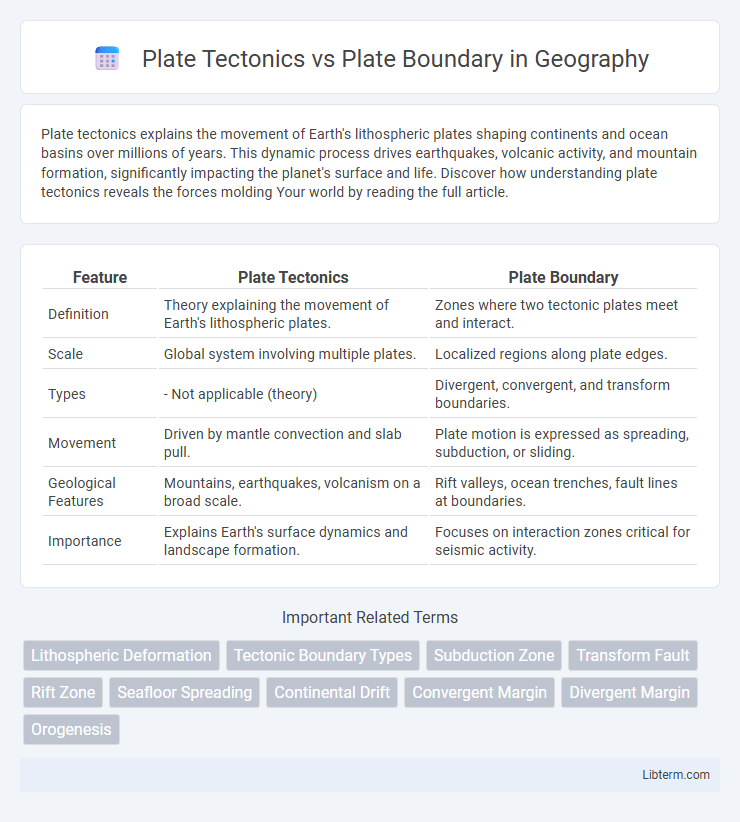Plate tectonics explains the movement of Earth's lithospheric plates shaping continents and ocean basins over millions of years. This dynamic process drives earthquakes, volcanic activity, and mountain formation, significantly impacting the planet's surface and life. Discover how understanding plate tectonics reveals the forces molding Your world by reading the full article.
Table of Comparison
| Feature | Plate Tectonics | Plate Boundary |
|---|---|---|
| Definition | Theory explaining the movement of Earth's lithospheric plates. | Zones where two tectonic plates meet and interact. |
| Scale | Global system involving multiple plates. | Localized regions along plate edges. |
| Types | - Not applicable (theory) | Divergent, convergent, and transform boundaries. |
| Movement | Driven by mantle convection and slab pull. | Plate motion is expressed as spreading, subduction, or sliding. |
| Geological Features | Mountains, earthquakes, volcanism on a broad scale. | Rift valleys, ocean trenches, fault lines at boundaries. |
| Importance | Explains Earth's surface dynamics and landscape formation. | Focuses on interaction zones critical for seismic activity. |
Introduction to Plate Tectonics and Plate Boundaries
Plate tectonics is the scientific theory explaining the movement of Earth's lithospheric plates, which float on the semi-fluid asthenosphere beneath them. Plate boundaries are the edges where two tectonic plates meet, and they are classified into three main types: divergent, convergent, and transform boundaries, each characterized by distinct geological activities. Understanding plate boundaries is essential for studying earthquake zones, volcanic activity, and mountain formation associated with plate tectonics.
Defining Plate Tectonics: The Driving Forces
Plate tectonics explains the movement of Earth's lithospheric plates driven by mantle convection, slab pull, and ridge push forces. These forces cause plates to interact at plate boundaries, leading to geological phenomena such as earthquakes, volcanic activity, and mountain formation. Understanding the dynamics of plate tectonics is crucial for comprehending the behavior of divergent, convergent, and transform plate boundaries.
Understanding Plate Boundaries: Types and Features
Plate boundaries represent the edges where tectonic plates meet, classified into divergent, convergent, and transform types, each exhibiting distinct geological features and seismic activity. Divergent boundaries involve plates moving apart, forming mid-ocean ridges and rift valleys, while convergent boundaries cause subduction zones or mountain ranges due to plates colliding. Transform boundaries slide plates laterally, generating strike-slip faults and earthquakes, critical for understanding Earth's dynamic crust and associated natural hazards.
Key Differences Between Plate Tectonics and Plate Boundaries
Plate tectonics refers to the scientific theory explaining the movement of Earth's lithospheric plates, which shape the planet's surface over geological time. Plate boundaries are the distinct zones where two tectonic plates meet and interact, classified as divergent, convergent, or transform boundaries, each exhibiting unique geological activities such as earthquakes, volcanism, or mountain-building. Understanding plate tectonics involves studying the mechanisms driving plate movements, while plate boundaries focus on the specific interactions and phenomena occurring at the edges of these moving plates.
The Role of Plate Tectonics in Shaping Earth's Surface
Plate tectonics drives the movement of Earth's lithospheric plates, shaping the planet's surface through processes such as continental drift, mountain formation, and seismic activity. Plate boundaries, including divergent, convergent, and transform types, serve as dynamic zones where plates interact, leading to phenomena like earthquakes, volcanic eruptions, and ocean basin formation. Understanding plate tectonics is essential for explaining the distribution of geological features and the ongoing reshaping of Earth's surface over geological time.
Classification of Plate Boundaries: Divergent, Convergent, and Transform
Plate boundaries are classified into three main types based on the movement of tectonic plates: divergent, convergent, and transform boundaries. Divergent boundaries occur where plates move apart, creating new crust typically at mid-ocean ridges. Convergent boundaries form where plates collide, often resulting in mountain ranges or deep ocean trenches, while transform boundaries involve plates sliding past each other horizontally, causing earthquakes along faults like the San Andreas Fault.
Interactions at Plate Boundaries: Earthquakes and Volcanoes
Interactions at plate boundaries are crucial in understanding the dynamics of earthquakes and volcanoes, where three primary types of boundaries--divergent, convergent, and transform--trigger seismic activity. Earthquakes predominantly occur along transform boundaries due to lateral sliding of plates, while convergent boundaries often generate powerful earthquakes and volcanic eruptions as one plate subducts beneath another. Volcanic activity is most intense at convergent boundaries, such as the Pacific Ring of Fire, and at divergent boundaries like mid-ocean ridges where magma rises to form new crust.
Plate Tectonics Versus Plate Boundary Dynamics
Plate tectonics describes the large-scale movement of Earth's lithospheric plates driven by mantle convection, slab pull, and ridge push forces, while plate boundary dynamics focus specifically on interactions at the edges of these plates, such as divergent, convergent, and transform boundaries. Understanding plate tectonics provides the broader context for processes like subduction, mountain building, and seafloor spreading, whereas plate boundary dynamics elucidate localized phenomena including earthquake generation and volcanic activity. These dynamics are critical for predicting geological hazards and interpreting the geological evolution of Earth's crust.
Real-World Examples of Plate Tectonic Movements and Boundary Activity
The San Andreas Fault in California exemplifies a transform plate boundary where the Pacific Plate slides horizontally past the North American Plate, causing frequent earthquakes. The Himalayas formed from the convergent boundary between the Indian Plate and the Eurasian Plate, showcasing intense mountain-building due to plate collision. The East African Rift Valley represents a divergent boundary, where the African Plate is splitting into smaller plates, resulting in volcanic activity and rifting.
Conclusion: Importance of Distinguishing Plate Tectonics from Plate Boundaries
Distinguishing plate tectonics from plate boundaries is crucial for understanding Earth's dynamic processes and predicting geological events. Plate tectonics refers to the movement of Earth's lithospheric plates, while plate boundaries are the specific zones where these plates interact, such as divergent, convergent, or transform boundaries. Accurate differentiation enhances seismic hazard assessment, resource exploration, and environmental management.
Plate Tectonics Infographic

 libterm.com
libterm.com